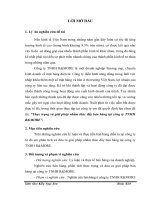More igneous rocks
Bạn đang xem bản rút gọn của tài liệu. Xem và tải ngay bản đầy đủ của tài liệu tại đây (3.2 MB, 31 trang )
In Lecture Today:
1. Geology in the news presentation by Michael
Zara.
2. Classification of igneous rocks.
3. Nature and classification of igneous plutons.
4. Origins of magma and relationship to plate
tectonic setting.
Naming Igneous Rocks
Igneous rocks are classified by their:
Texture
depends on: how fast/slow magma cools
Mineral Composition
depends on: chemical makeup of parent magma
Cooling rate
in igneous
rocks
is determined
by
Fig. 6.15
cooling rate,
which is in
turn,
determined
by proximity to
the surface.
W. W. Norton
Coarse-grained
Fine-grained
or “phaneritic”
or “aphanitic”
Fig. 6.16a
0 Mm 0.5
Grain size in igneous rocks
is determined by cooling rate.
Photod by Dr. Kent Ratajeski, Dept. Geology and Geophysics, University of Wisconsin, Madison
0 Mm 0.5
Fig. 6.14cd
Stephen Marshak
Fig. 6.12
W. W. Norton
Fig. 6.19
Stephen Marshak
Naming Igneous Rocks
Basic magma types:
Mafic
magnesium + ferrum
High in Mg, Fe. Dark, dense
Felsic
feldspar + silica (quartz)
High in Si. Lighter, less dense
Naming igneous rocks
Mafic
Aphanitic
Gabbro
Phaneritic
plutonic
Basalt
volcanic
Zooming in:
Fig. 6.17a
Figure 6.17
Text, page 155
Naming igneous rocks
Aphanitic
Diorite
Phaneritic
volcanic
Andesite
plutonic
In t e r m e d i a t e
Zooming in
Fig. 6.17a
Figure 6.17
Text, page 155
Naming igneous rocks
Aphanitic
Granite
Phaneritic
plutonic
Felsic
Rhyolite
volcanic
Zooming in:
Fig. 6.17a
W. W. Norton. Mineral proportions
after Hamblin and Howard.
Naming Igneous Rocks:
Upper mantle plutonic
igneous rocks,
“peridotite” or “dunite”.
(Near Globe, AZ)
Ultramafic: ~ 40% Silica
(less than gabbro/basalt,
with more Fe and Mg).
Naming Igneous Rocks:
Glassy Volcanic Rocks
Felsic
Obsidian
Pumice
Volcanic Glass
Volcanic “Froth”
Bowen’s Reaction Series
Magmas don’t
crystallize all at once!
Minerals with the highest
melting temperatures come
out first, followed by
minerals with successively
lower melting temperatures.
The sequence of silicate
mineral crystallization in
magmas was first studied by
University of Chicago
geologist, N.L Bowen, in the
1920’s.
Bowen’s Reaction Series
Box 6.2 Text, page 145.
Fig. 6.06
W. W. Norton
This diagram shows the order in which silicate
minerals crystallize from magma and how that
Relates to mineral content and rock type.
Basaltic lavas are very fluid and travel far from the vent to
produce volcanoes with low profiles.
Basalt eruptions on land produce flows
that travel great distances.
Fig. 6.20a
W. W. Norton
Columbia River
basalts
Basaltic lavas erupted under water produce “pillows”
Fig. 6.21a
W. W. Norton
Fig. 6.21b
Stephen Marshak
Fig. 6.21c
© Peter Kresan









